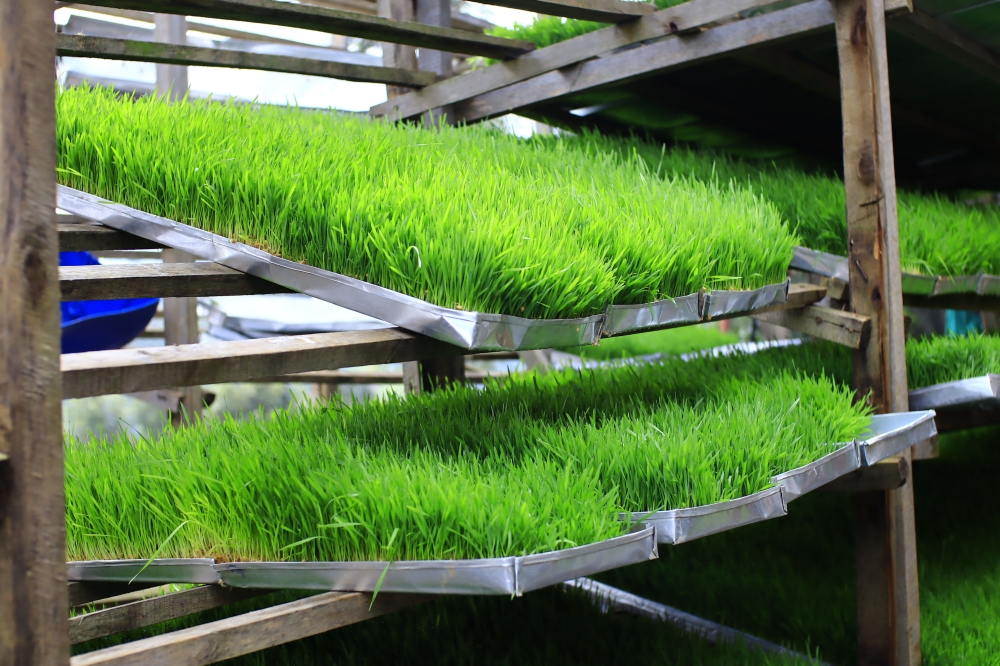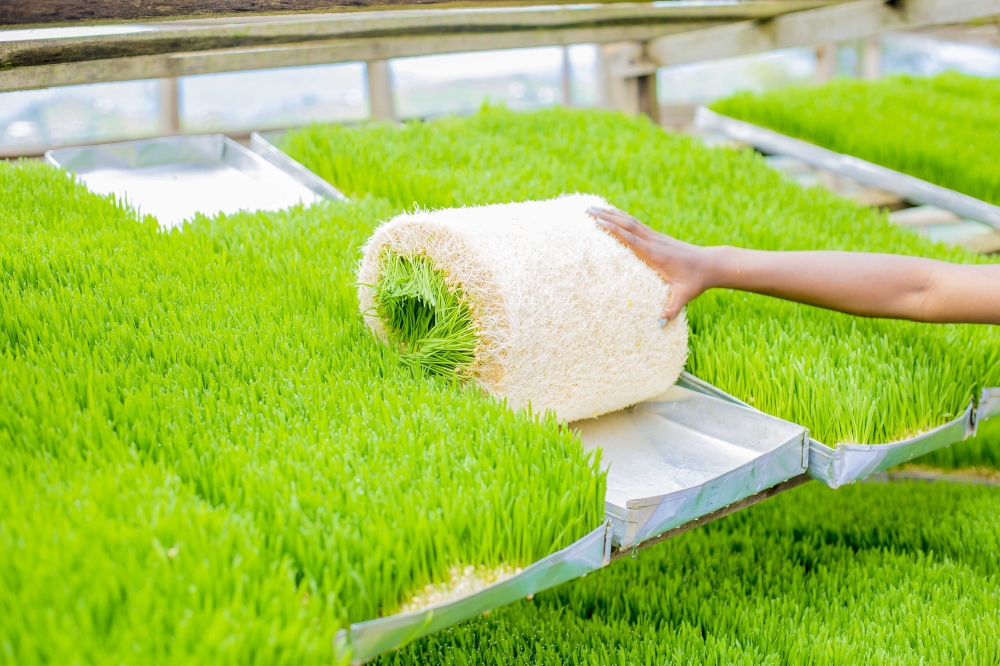The Rwanda Agriculture and Animal Resources Development Board (RAB) is working with farmers and the private sector to increase the area covered with various fodder varieties from 32,000 hectares to 87,000 hectares by promoting hydroponic fodder cultivation. This approach aims to alleviate forage and feed shortages for cattle, boosting milk production and supporting small livestock during dry seasons over the next five years.
Hydroponic farming is being encouraged as Rwanda prepares to open its first milk powder factory in Nyagatare District this week, necessitating higher milk production. This method produces fodder by growing seeds without soil and using minimal water. In just six to seven days, the seeds develop into 30-35-centimeter-tall seedlings that provide highly nutritious feed.
The process involves placing selected grains in specially treated trays without soil and spraying them with a nutrient-rich water solution at regular intervals. This method does not require electricity but does need a reliable source of potable water.
After seven days, the fodder is ready for animal consumption, with the entire plant (roots, leaves, and seeds) being utilized, making the system waste-free. Producing one kilogram of this fodder uses between 800 milliliters and one liter of water, in contrast to the 80-90 liters needed to grow a kilogram of green grass in soil.
This technology is included in the 5th Strategic Plan for Agriculture Transformation (PSTA5), which commenced in 2024. Mupenzi Mutimura, a researcher in feed resources and animal nutrition at RAB, pointed out that the government’s zero-grazing policy has created a greater need for increased fodder and feed production.
Research has been conducted to find suitable fodder varieties for each agro-ecological zone in Rwanda. Currently, there are 31 varieties of fodder from legumes and over 20 from cereals, with nine varieties being grown on a large scale by farmers with limited land using hydroponic technology. Mutimura explained that hydroponic fodder boosts the immune system and enhances milk and meat production due to its high protein content. Facilities for hydroponic fodder have been set up in Ngoma, Rwamagana, Gicumbi, Nyabihu, Rubavu, Kayonza, and Gatsibo districts. Although the production of hydroponic fodder is not yet sufficient, progress is being made.

The aim is to meet 85% of the livestock fodder needs, with a substantial contribution from hydroponic fodder. This technology also plays a role in reducing methane emissions in the livestock sector.
The agriculture sector is the main source of methane emissions in Rwanda, largely due to enteric fermentation and manure management in livestock. The country plans to cut methane emissions by 30%, with a particular focus on the agriculture sector.
University graduates’ participation
Jackson Karara, president of the Uruhimbi Kageyo Cooperative in Gicumbi District, reported that since 2020, they have been providing hydroponic fodder to farmers across seven districts, starting with an initial investment of Rwf12 million.
Currently, they support over 300 farmers but need additional financial backing to grow. The cooperative offers hydroponic fodder at different rates depending on the type of livestock: Rwf80 to Rwf120 per kilogram for cows, Rwf180 for pigs, rabbits, goats, and sheep, Rwf260 for chickens, and Rwf330 for fish. Harvesting times vary by animal: four days for poultry, six days for pigs, rabbits, goats, and sheep, three days for fish, and seven days for cows.
The cooperative has also trained over 150 youths, including those with disabilities, refugees, and women, and 2,000 farmers in hydroponic fodder cultivation to generate employment. Karara emphasized that this green fodder increases milk production year-round and can feed 10 cows on just 12 square meters.
He added that setting up a hydroponic fodder facility costs between Rwf1.5 million and Rwf2.5 million and can last up to seven years, including training expenses. With high demand for hydroponic fodder, further investments and low-interest loans are needed. The initiative has also contributed to a 42% reduction in methane emissions from livestock.
Advantages for Farmers in Areas at Risk of Drought
Francis Nkurunziza, a livestock farmer from Mwogo sector in Bugesera District, described how extended dry spells from May to October 2021 cut his milk production in half and led to the loss of six cows. The lack of irrigation systems meant that planted fodder did not survive, causing disputes among farmers over scarce resources. Hydroponic fodder could have alleviated these challenges.
In Nyagatare District, milk production often drops from 90,000 liters to 40,000 liters per day during dry seasons, which drives up milk prices. Samuel Kayumba, a dairy farmer from Nyagatare, noted that his milk yield decreased from 50 liters per day during the rainy season to 30 liters per day in July due to the drought. On the other hand, Clementine Mukangarambe, a farmer from Rwamagana District, reported that hydroponic fodder had doubled her cow’s milk production from five liters.
Hydroponic fodder provides a sustainable solution to fodder shortages and milk production issues, particularly in drought-prone areas, enhancing Rwanda’s agricultural sector and climate resilience.



